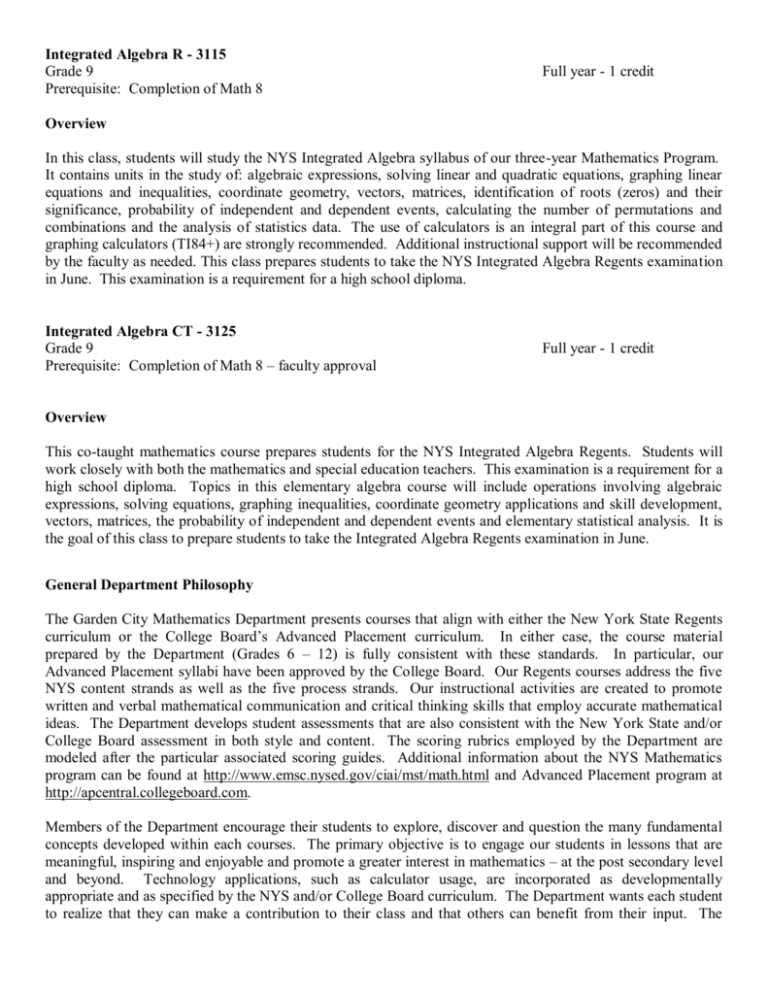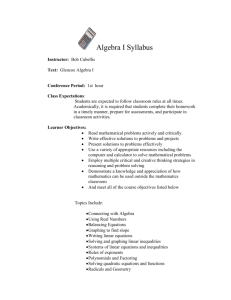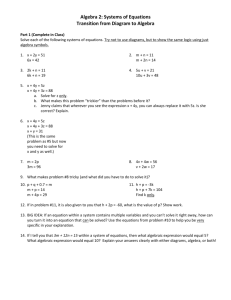Integrated Algebra – Curriculum
advertisement

Integrated Algebra R - 3115 Grade 9 Prerequisite: Completion of Math 8 Full year - 1 credit Overview In this class, students will study the NYS Integrated Algebra syllabus of our three-year Mathematics Program. It contains units in the study of: algebraic expressions, solving linear and quadratic equations, graphing linear equations and inequalities, coordinate geometry, vectors, matrices, identification of roots (zeros) and their significance, probability of independent and dependent events, calculating the number of permutations and combinations and the analysis of statistics data. The use of calculators is an integral part of this course and graphing calculators (TI84+) are strongly recommended. Additional instructional support will be recommended by the faculty as needed. This class prepares students to take the NYS Integrated Algebra Regents examination in June. This examination is a requirement for a high school diploma. Integrated Algebra CT - 3125 Grade 9 Prerequisite: Completion of Math 8 – faculty approval Full year - 1 credit Overview This co-taught mathematics course prepares students for the NYS Integrated Algebra Regents. Students will work closely with both the mathematics and special education teachers. This examination is a requirement for a high school diploma. Topics in this elementary algebra course will include operations involving algebraic expressions, solving equations, graphing inequalities, coordinate geometry applications and skill development, vectors, matrices, the probability of independent and dependent events and elementary statistical analysis. It is the goal of this class to prepare students to take the Integrated Algebra Regents examination in June. General Department Philosophy The Garden City Mathematics Department presents courses that align with either the New York State Regents curriculum or the College Board’s Advanced Placement curriculum. In either case, the course material prepared by the Department (Grades 6 – 12) is fully consistent with these standards. In particular, our Advanced Placement syllabi have been approved by the College Board. Our Regents courses address the five NYS content strands as well as the five process strands. Our instructional activities are created to promote written and verbal mathematical communication and critical thinking skills that employ accurate mathematical ideas. The Department develops student assessments that are also consistent with the New York State and/or College Board assessment in both style and content. The scoring rubrics employed by the Department are modeled after the particular associated scoring guides. Additional information about the NYS Mathematics program can be found at http://www.emsc.nysed.gov/ciai/mst/math.html and Advanced Placement program at http://apcentral.collegeboard.com. Members of the Department encourage their students to explore, discover and question the many fundamental concepts developed within each courses. The primary objective is to engage our students in lessons that are meaningful, inspiring and enjoyable and promote a greater interest in mathematics – at the post secondary level and beyond. Technology applications, such as calculator usage, are incorporated as developmentally appropriate and as specified by the NYS and/or College Board curriculum. The Department wants each student to realize that they can make a contribution to their class and that others can benefit from their input. The Department wants all students to maximize their mathematical potential as we move through the challenging curriculum and prepare to master all course requirements. Integrated Algebra – Content and Skills 1. Real Numbers a. Properties of real numbers b. Math systems, Set theory c. Solving linear equations d. Literal equations e. Translating verbal phrases f. Analyzing and solving word problems g. Rates, rations and Proportions h. Percent word problems, percent of change, percent error i. Laws of exponents and scientific notation 2. Graphs of linear equations a. Table of values 1. Functions vs. relations b. Slope c. x- and y-intercepts d. Slope-intercept form e. Direct variation f. Solving linear inequalities g. Graphs of linear inequalities 3. Systems of linear equations and inequalities a. Solving graphically and checking b. Word problems c. Solving algebraically and checking 4. Vectors and Matrices a. Solve problems, such as velocity using vectors b. Solve problems, such as systems of equations using matrices 5. Polynomials a. Operations with polynomials (addition, subtraction, multiplication and division) b. Word problems c. Factoring d. Non-linear functions: quadratic equations – solving by factoring e. Graphing parabolas f. Solving graphically and checking g. Quadratic word problems h. Quadratic-linear systems – graphic and algebraic solutions i. Algebraic proportions that result in quadratic equations j. Exponential functions k. Absolute value functions l. Algebraic fractions 6. Radicals a. Simplifying b. Addition, subtraction, multiplication, division c. Applications involving Pythagorean Theorem d. Trigonometry e. Sine, Cosine and Tangent f. Angles of elevation and depression g. Using trigonometry to find length of missing side or measure of an angle h. Word problems 7. Geometry a. Perimeter b. Area c. Surface area d. Volume e. Word problems 8. Probability and statistics a. And & or – single events b. Independent events c. Conditional – with and without replacement d. Permutations and factorial e. Measures of central tendency f. Histograms g. Box and Whisker plots h. Line of best fit – Linear regression i. Interpolation and extrapolation Primary Resources Course: Integrated Algebra R/CT Title of Resource: Amsco's Integrated Algebra Author: Ann Xavier Gantert Publisher: Amsco On-Line Text: Integrated Algebra On-Line Practice and Review: www.castlelearning.com







